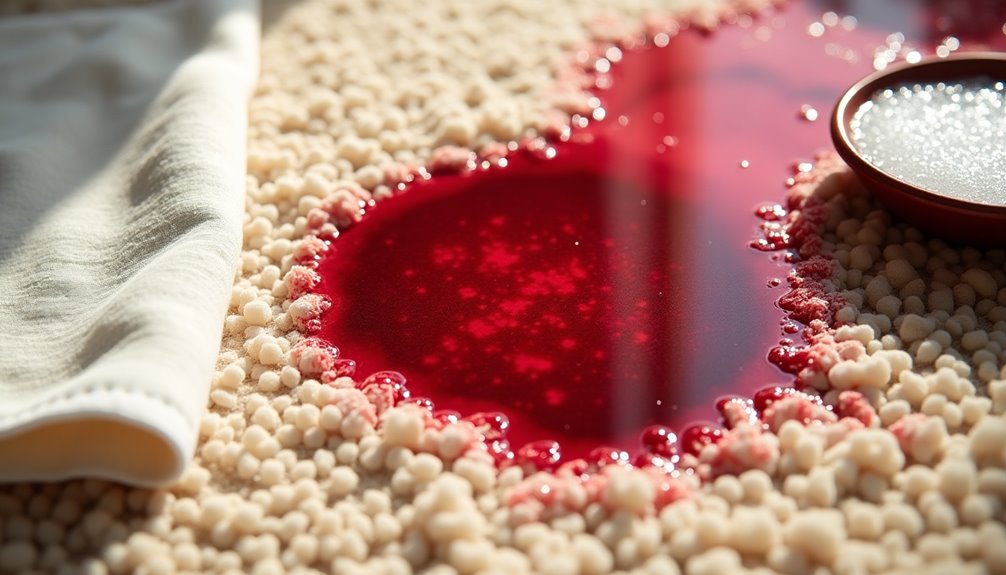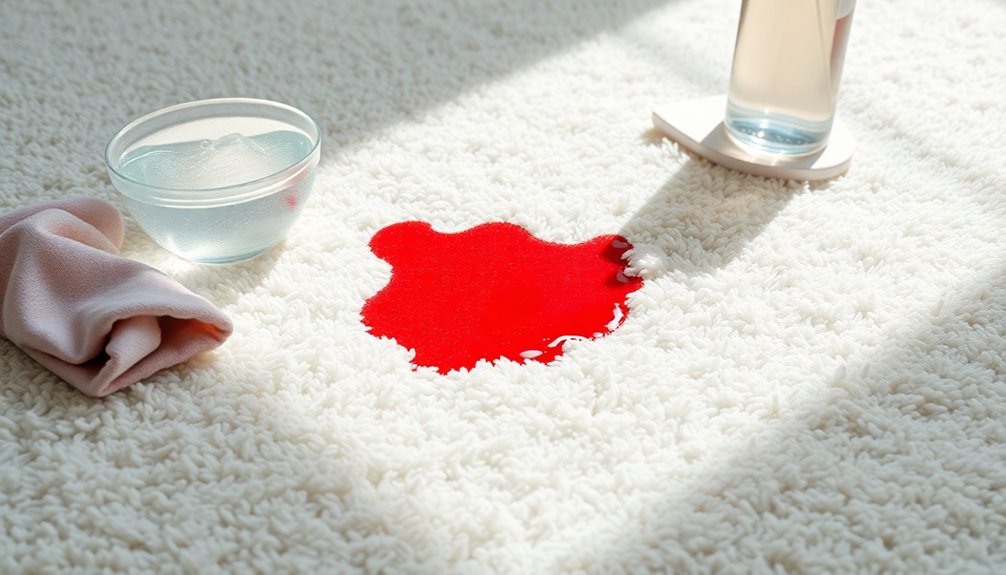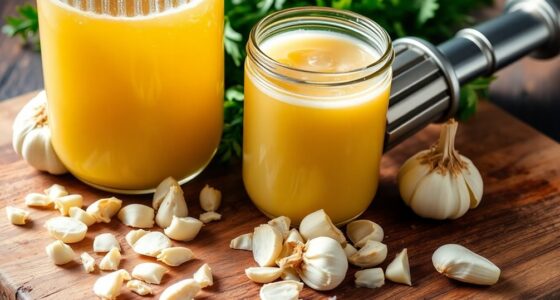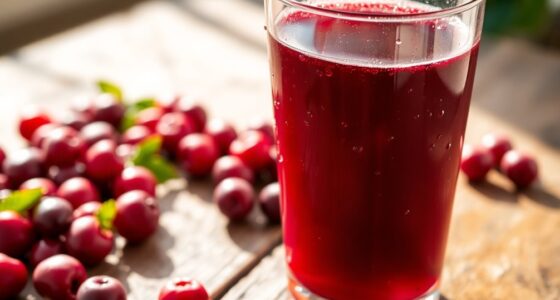To quickly remove a juice stain from your carpet, act fast. Blot the area with a clean cloth to absorb as much liquid as possible. Next, mix one tablespoon of dishwashing liquid with two cups of warm water and apply it with a sponge, continuing to blot the stain. If it persists, try a solution of one tablespoon of ammonia or equal parts vinegar and water. Want more tips for tackling stubborn stains? There's more to discover!
Key Takeaways
- Act quickly by blotting the juice stain with a clean cloth to absorb excess liquid without rubbing.
- Prepare a cleaning solution using one tablespoon of dishwashing liquid mixed with two cups of warm water.
- Apply the cleaning solution with a sponge, blotting the stained area and alternating with a clean cloth.
- For stubborn stains, use a vinegar solution (½ cup white vinegar mixed with ½ cup water) and test on a hidden area first.
- Ensure the area is completely dry by placing a towel over it and weighing it down for several hours.

If you act quickly, getting a juice stain out of your carpet can be a straightforward process. The key is to address the stain immediately to prevent it from setting in. Start by grabbing a clean cloth or some paper towels, and gently blot the stain. It's crucial to apply pressure without rubbing—rubbing can spread the juice and make the stain worse. You want to absorb as much of the liquid as possible before moving on to a cleaning solution.
Once you've blotted as much juice as you can, it's time to mix up a cleaning solution. A simple yet effective option is to combine one tablespoon of dishwashing liquid with two cups of warm water. Take a clean sponge, dip it into the mixture, and gently apply it to the stained area. Continue to blot with the sponge, alternating with your clean cloth, until the stain begins to lift. You'll see progress if you keep at it, but don't rush the process. Patience is key when it comes to removing stains from your carpet.
If the stain is particularly stubborn and doesn't seem to be budging, you might need a stronger approach. Consider mixing one tablespoon of ammonia with two cups of warm water, or you can go for a vinegar solution made from ½ cup of white vinegar mixed with ½ cup of water. Again, test this solution on a hidden part of the carpet first to ensure it won't cause discoloration or damage. Once you've confirmed it's safe, apply the solution to the stain and continue to blot until it lifts.
After you've successfully removed the juice stain, it's important to ensure that the area is completely dry to prevent any re-staining. To do this, place a dry towel over the cleaned area. Then, weigh it down with a heavy object, like a book or a dumbbell. Leave it there for a few hours. The towel will absorb any remaining moisture, helping to keep your carpet looking fresh and clean.
Once you've completed these steps, check the area to make sure the stain is completely gone. If it's not, don't be discouraged; sometimes, it takes a bit of persistence to fully remove a stain. Just remember to always act quickly and use the right techniques to prevent the juice from setting.
With a little effort, you can keep your carpet looking pristine, even after a juice spill. So, keep those cleaning solutions handy and be ready to tackle any unexpected messes that come your way!
Frequently Asked Questions
Does Juice Come Out of Carpet?
Yes, juice can come out of carpet if you act quickly.
You'll want to blot the stain immediately with a clean cloth to absorb as much liquid as possible.
Then, use a mixture of dish soap and warm water or vinegar and water to treat the area.
For tougher stains, you might need a stronger solution.
Just be cautious to avoid damaging your carpet.
If all else fails, consider calling a professional cleaner.
Can Juice Stains Be Removed?
Juice stains can definitely be dealt with! If you act fast, you can usually remove them without a hitch.
Start by blotting the stain to soak up excess liquid, then try a solution of dish soap and warm water or vinegar.
For tougher stains, you might need something stronger, like ammonia. Just remember to test any cleaner first.
If all else fails, a pro's help can make a world of difference!
How to Get Liquid Stains Out of Carpet?
To get liquid stains out of your carpet, start by blotting the area with a clean cloth to absorb excess liquid—don't rub, as it spreads the stain.
Next, dampen the stain to dilute it.
Mix a tablespoon of dish soap with two cups of warm water and apply this solution using a sponge.
Press gently, blotting until the stain lifts.
Finally, rinse the area with water and absorb remaining moisture with a dry towel.
How Do You Get Stains Out of Carpet That Have Been Dried?
Getting dried stains out of carpet can feel like trying to unstick a gum on a hot day.
First, you'll want to moisten the area with a mix of one tablespoon of dish soap and two cups of warm water.
Use a clean sponge to blot the stain, pressing gently. If it's stubborn, let the solution sit for 10 minutes.
Rinse with cold water and blot dry. Keep repeating until the stain is gone!
Conclusion
By following these simple steps, you can banish that juice stain from your carpet like it never existed! Remember to act quickly, and don't forget to test any cleaning solution on a small area first. With a little patience and persistence, your carpet will look as good as new, and you'll feel like a stain-fighting superhero. So grab your cleaning supplies and conquer that stain—your carpet deserves to shine bright once again!
Cindy thoroughly researches juicing trends, techniques, and recipes to provide readers with practical advice and inspiration. Her writing style is accessible, engaging, and designed to make complex concepts easy to understand. Cindy’s dedication to promoting the advantages of juicing shines through her work, empowering readers to make positive changes in their lives through the simple act of juicing.











